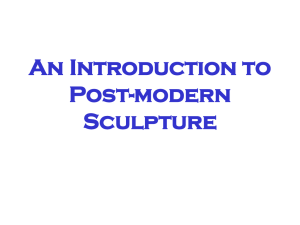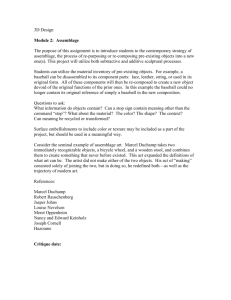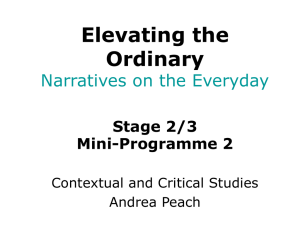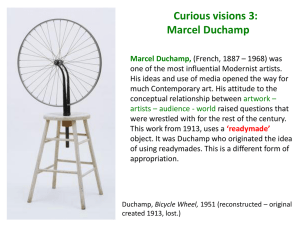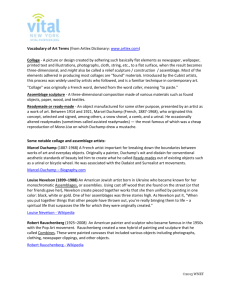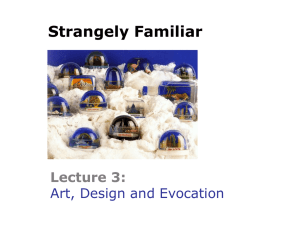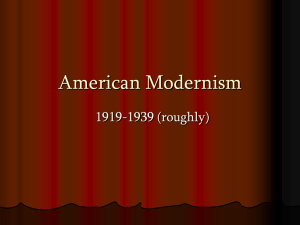jenny holzer
advertisement
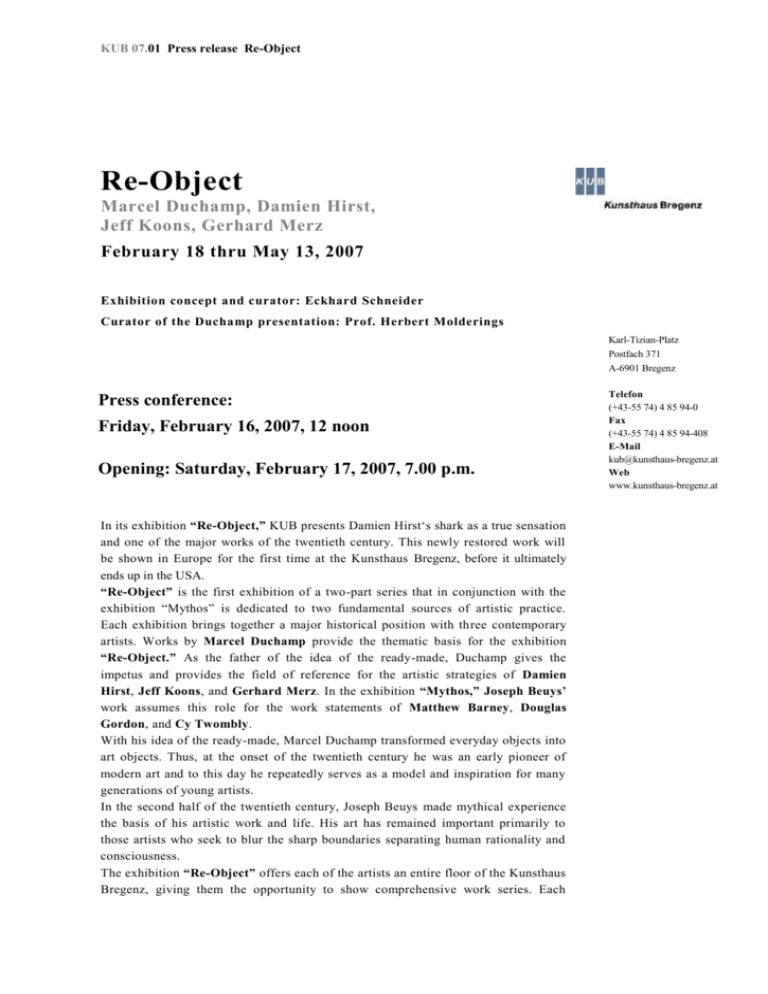
KUB 07.01 Press release Re-Object Re-Object Marcel Duchamp, Damien Hirst, Jeff Koons, Gerhard Merz February 18 thru May 13, 2007 Exhibition concept and curator: Eckhard Schneider Curator of the Duchamp presentation: Prof. Herbert Molderings Karl-Tizian-Platz Postfach 371 A-6901 Bregenz Press conference: Friday, February 16, 2007, 12 noon Opening: Saturday, February 17, 2007, 7.00 p.m. In its exhibition “Re-Object,” KUB presents Damien Hirst‘s shark as a true sensation and one of the major works of the twentieth century. This newly restored work will be shown in Europe for the first time at the Kunsthaus Bregenz, before it ultimately ends up in the USA. “Re-Object” is the first exhibition of a two-part series that in conjunction with the exhibition “Mythos” is dedicated to two fundamental sources of artistic practice. Each exhibition brings together a major historical position with three contemporary artists. Works by Marcel Duchamp provide the thematic basis for the exhibition “Re-Object.” As the father of the idea of the ready-made, Duchamp gives the impetus and provides the field of reference for the artistic strategies of Damien Hirst, Jeff Koons, and Gerhard Merz. In the exhibition “Mythos,” Joseph Beuys’ work assumes this role for the work statements of Matthew Barney, Douglas Gordon, and Cy Twombly. With his idea of the ready-made, Marcel Duchamp transformed everyday objects into art objects. Thus, at the onset of the twentieth century he was an early pioneer of modern art and to this day he repeatedly serves as a model and inspiration for many generations of young artists. In the second half of the twentieth century, Joseph Beuys made mythical experience the basis of his artistic work and life. His art has remained important primarily to those artists who seek to blur the sharp boundaries separating human rationality and consciousness. The exhibition “Re-Object” offers each of the artists an entire floor of the Kunsthaus Bregenz, giving them the opportunity to show comprehensive work series. Each Telefon (+43-55 74) 4 85 94-0 Fax (+43-55 74) 4 85 94-408 E-Mail kub@kunsthaus-bregenz.at Web www.kunsthaus-bregenz.at 2/9 KUB 07.01 Press release Re-Object presentation is similar to a solo exhibition and takes on the character of a theme focused work statement. Each artist represents a distinct approach to dealing with the theme, and neither Damien Hirst nor Jeff Koons or Gerhard Merz have ever shown such a concentrated body of key works in conjunction with Duchamp. Damien Hirst uses his cabinets as coldly shining traps of death and destructi on. Jeff Koons takes his everyday objects turned artwork one step further, transforming them through the perfect presentation of outward appearances into “objects of desire.” Finally, Gerhard Merz’s work as a theoretical model and demonstration piece consisting of painting and an industrial light installation does away with aesthetic conventions. A comprehensive catalogue will be published in conjunction with each exhibition and a parallel program of events will elucidate the artists’ works in the context o f the themes. Marcel Duchamp When Marcel Duchamp invented his first ready-mades, no one imagined the explosive impact this would have on contemporary art. With the “Bicycle Wheel,” “Fountain,” and “Advance of the Broken Arm” (all works shown in the exhibition), real objects took their places on the “empty throne” of artistic creation. The art historian Herbert Molderings, one of the most distinguished Duchamp scholars and curator of the exhibition at the Kunsthaus Bregenz, notes in his standard work on Marcel Duchamp that this artist has influenced twentieth century art to an extent comparable otherwise only to Pablo Picasso’s impact. In the foreword of his book he writes: “Duchamp’s invention, the ready-made, in which objects of everyday use are transformed into works of art, is the very cornerstone of Dadaism and Surrealism. It created completely new conditions for what we call sculpture. Neither American and British Pop Art, French Nouveau Réalisme, the international Fluxus movement, nor any conceptual art forms would have been conceivable without Marcel Duchamp as their role model. Even today, his works continue to inspire generations of artists. Every postmodern and deconstructivist position in the art of the eighties and nineties has emerged from Duchamp’s undogmatic, skepticist aesthetics.” Marcel Duchamp pursued a kind of double strategy in his work. With the readymades he radically challenged a concept that audiences had drawn from craftsmanship. These works called for a re-examination of the identity of art and craftsmanship and of the nature of depiction and imitation. Thus Duchamp not only questioned the role of the artist but also shed light on the conditions that influence how art is judged. Duchamp’s ready-mades were never the result of simple acts of selection declaring trivial objects to be objects of art; rather, they were instruments of philosophical and aesthetic thought experiments. He published these as facsimile notes in precious “box” editions: “La Mariée mise à nu par ses célibataires, même,” 3/9 KUB 07.01 Press release Re-Object (The Green Box), 1934; “A l’Infinitif” (The White Box), 1967. From 1935 to 1941, he produced a catalogue of his oeuvre in the form of a portable museum: “La Boîte en-valise” (The Box in a Suitcase). All three of these can be seen in the exhibition. The decisive turn of events for today’s reception of the ready-mades came from André Breton. In 1936, when one of Duchamp’s classic ready-mades, the “Bottle Rack,” was shown publicly for the first time, Breton disengaged the object from its original experimental significance with his definition of the ready-made as “an ordinary object elevated to the dignity of a work of art by the mere choice of an artist.” This shift in interpretation is also the point of departure for Herbert Molderings’ concept for the Duchamp show. He puts the ready-mades back into the artist’s studio, presenting them in this way in the context that Marcel Duchamp himself had used them. “It is not the objects that count but the experiments.” (Molderings) For Duchamp, the idea of the ready-made was not about the objects themselves nor about raising trivial objects to the status of aesthetic works, their purpose “was not to serve as exhibition pieces but as objects of experimental perception.” Duchamp’s studios in New York, which doubled as his living spaces and are depicted in the exhibition as three large-scale enlargements, were thus not work production centers, but “perception laboratories” in which the ready-mades served as installations for the new spatial models that Duchamp was testing while working on his masterpiece, the “Large Glass.” With his ready-mades Duchamp managed to build a creative atmosphere in his living and working space, making it possible to conceive of space or reality itself in an unconventional manner: undefined, flexible, and open. Damien Hirst The heart of this show of Damien Hirst’s work is a four-meter-long tiger shark preserved in twenty tons of diluted formaldehyde. In reference to this work, which became the key work of the Young British Art movement, Rose-Maria Gropp wrote the following in the FAZ in June 2006: “If the 1990s has an iconic work of art, it is the British artist Damien Hirst’s tiger shark preserved in formaldehyde. This tank with the dead predator fish is one of the most striking symbols of the transitoriness that art brought forth in the second half of the twentieth century.” When the artist decided to replace the original shark, which had deteriorated dramatically since its unveiling in 1991, an international media debate about the work sprang up. Over the past few months, Hirst has completed this project in his London studio, and now KUB is presenting this major piece along with other key works by the artist before the “reloaded version” leaves Europe en route to Steven A. Cohen’s private collection in New York. Among the other works on display are several monumental nine- and twelve-meter-long “pharmaceutical paintings,” one of the famous medical cabinets, and a large, newly produced cabinet. 4/9 KUB 07.01 Press release Re-Object Damien Hirst is, in a certain sense, the alpha wolf in the British art scene, which as the Young British Art movement stirred up British society’s relationship to contemporary art by addressing themes like death, life, and sex. Damien Hirst has become one of the most highly respected artists on both si des of the Atlantic; his public impact has become so tremendous that even people with little interest in art are familiar with his work such as the shark tank. This is certainly in no small part due to the fact that Damien Hirst has never restricted himsel f to any traditional, narrow image of the artist. By the late eighties, he already organized the exhibitions “Freeze 1988” and “Modern Medicine 1990,” which became the seeds of the new artist generation. He shot commercial music videos, produced pop songs, and has over the years amassed a considerable art collection that includes works by Jeff Koons. The core of his artistic practice as painter and sculptor, however, is his work on art itself. His themes are life, disease, death, and destruction. Dedicated to the concept of the ready-made by Marcel Duchamp, Hirst’s stainless steel and glass cabinets filled with animals, medical instruments, and pills seem like the perfect minimalistically constructed traps of a Donald Judd. “Duchamp’s ready-mades have been transposed from the morgue and the operation theatre to the gallery on the basis of the cold cargo of dread and terror that they carry.” (Gordon Burn) Even the “pharmaceutical paintings” with their cool methodology of using unmixed colors as the found and selected, off-the-rack products of industrialized manufacturing remind us of Duchamp’s painting concepts. In reality, however, Damien Hirst’s works and installations nonchalantly tell of the battle of life against death and thus, as opposed to Marcel Duchamp’s works, they do not rely on ironic distance, jarring intellectual juxtaposition, and fragmentation, but mean the real horror they show as the permanent symbol of the fight for survival as a confrontation with the fragility of existence and the closeness to death that man seeks to push out of his consciousness. Jeff Koons For more than 25 years, Jeff Koons has kept the art world on its toes by practicing art as a kind of highly skilled form of communication based on the simple message of a fundamental faith in one’s own strengths and the strengths of the audience. An American dream that fits together with the artistic-intellectual legacy of a Marcel Duchamp without a break and also taps the rich European tradition of craftsmanship. If we take Koons’ entire oeuvre into consideration, the notion of the revival of a universal representation of the arts for today’s society does not appear the least bit absurd. Koons specifically implements the strategies of mass culture in order to transform objects of everyday American consumer culture into gleaming objects of desire and beauty. 5/9 KUB 07.01 Press release Re-Object It all began in 1979 with Inflatables, a work series based on the awareness that there is nothing left for the artist to invent and that, therefore, all you can do is select certain items (the work consists of an inflatable bunny and flower on precut mirrored tiles; Koons bought both in stores). With his next two series, The New, household appliances in luxury glass cases, and Equilibrium, water-filled cases with basketballs suspended inside, Koons rose to stardom in the New York art scene in the 1980s. From then on, he produced one work series after another. The exhibition in KUB brings together key works from a number of different series over the past twenty years: from Luxury and Degradation “J. B. Jim Beam Turner Train,” 19..; from Statuary “Rabbit,” one of the legendary works of his oeuvre, 19..; from Banality “Pink Panther,” 19..; from Made in Heaven “Ilona’s Asshole,” 19..; and as the peak of a more than ten-year production phase, two sculptures from the Celebration series “Tulips,” 19.., and “Balloon Dog,” 19... The exhibition will be rounded off with two recent works from the series Popeye and Hulk. In the exhibition, all the works and their messages of the emancipatory role of the viewer seem like perfect appropriations of the Duchampesque ready-made. In fact, however, through a simple aestheticization of art, Koons overcomes Marcel Duchamp’s critical discourse and the skepticism found in his work. Koons’ objects rely on faith, induced by perfectly formed and glossy surfaces, so that through innocence, beauty, and the sense of security all that is vulgar, pornographic, and merely material is transformed. Gerhard Merz For thirty years, Gerhard Merz has managed to consistently go his own way without sacrificing his artistic flexibility. In a toned-down state of objective construction, he first sought to render certain work and material forms presentable as art and to maintain this presentability. His work always revolved around three core artistic issues: the sustainability of the traditional in modernism (a theme he explored relating to Mies van der Rohe, Malewitsch, Mondrian, Newman, Reinhard, a.o.); the role of the artist in his far-from-brilliant, marginal significance when confronted with the cold resistance of the works; the imperatives of implementation and arrangement by which material devoid of meaning and sense can become presentable as art in perfect objectivity. The instruments for painting, sculpture, and architecture that he has developed to this end are infused with the conviction that it is modernism with its architectural means and certain conventions concerning dimension, color, light, area, and space that makes the form of abstraction in which no myths or surrogate realities are capable of making the sought-after void ineffectual. The advanced nature of Gerhard Merz’s 6/9 KUB 07.01 Press release Re-Object means and methods legitimizes in all clarity what Ad Reinhardt has called the dividing line between “all else and art as a radical exception.” With his work, Merz thus poses the fundamental question as to what an art that makes no false promises and is agnostic and cold is capable of achieving. In doing so, he assumes an adequate intellectual basis in himself as well as in his audience so that art, as Duchamp called for, will not be reduced to the individual meditation of mere aesthetic outward appearance. The unique aspect of his position, the radical elaboration of the instruments of art as a concept, and the unerring quality of his thoughts and actions have made Gerhard Merz one of the most renowned and influential German artists, who has always been represented with large-scale original works at major museums as well as at international exhibitions. For the exhibition “Re-Object” Merz has created a new work series consisting of three large-format paintings and a band of lights made of 400 luminescent bulbs. The light pouring from these industrial objets trouvés over the whole scene turns the paintings into demonstration pieces which are the victims of an intentionally employed aesthetic reduction. In this way, Gerhard Merz transcends the approach taken by Duchamp, whose art was not intended to be retinal. For Merz, the idea is to allow the next great artistic achievements to arise from “deletion” and “disintegration.” – “There is good reason to place one’s hopes in an impoverished art that has ceased to fascinate, only knows precision, and gives you sharp images. Each artwork as something absolute, as the enemy of another. No playing with art forms, no calculated production of art.” (Gerhard Merz) KUB-Publication Re-Object - Mythos Two catalogues will be published in conjunction with the theme-focused group exhibitions “Re-Object” and “Mythos,” which are dedicated to two major historical trends of the twentieth century and their continuation and transformation in contemporary artistic practice. Featuring Gerhard Merz, Damien Hirst, and Jeff Koons, “Re-Object” presents a number of current positions that are characterized by a strategy of expression fo r which the object is both starting-point and focus. Historically, this approach is rooted in the work of Marcel Duchamp, who will also be represented in the show with several pieces. In “Mythos,” which constitutes a contrary and at the same time related position, works by Douglas Gordon, Matthew Barney, and Cy Twombly will be shown in conjunction with those of Joseph Beuys. Each catalogue contains two essays introducing the subject, one treating it from a historical perspective, the other examining it from the point of view of contemporary developments in the arts. In addition, various noted authorities will contribute essays 7/9 KUB 07.01 Press release Re-Object on each of the four artists. Each of these books, richly illustrated with photos of the artists’ work as well as large-format images of many of the installations at the Kunsthaus Bregenz, documents how the selected artists fall under the themes of “object” or “myth.” Biographies and lists of exhibitions and bibliographies round off this survey of two major trends in twentieth-century art. Re-Object German/English Edited by Eckhard Schneider Designed by Hans Werner Holzwarth With contributions by H. Molderings, S. Egenhofer, G. Inboden Each volume is approximately 176 pages, 22 x 30 cm, Hhrdcover, cloth with dust jacket Tentative publication dates: “Re-Object” in conjunction with the exhibition: February/March 2007 “Mythos” in conjunction with the exhibition: July 2007 Price: each volume approx. 48 euros Two-volume set in a slipcase will be available starting July 2007: approx. 82 euros 8/9 KUB 07.01 Press release Re-Object Partners and Sponsors The Kunsthaus Bregenz would like to thank its partners for their generous financial support and the cultural commitment that goes along with it. Presenting sponsor Main sponsor Sponsor of the of the Kunsthaus Bregenz KUB Arena With kind support from Cultural bodies Hypo Landesbank Vorarlberg Kulturhäuser Betriebs- Gesellschaft der gesellschaft mbH Freunde des Kunsthaus Bregenz 9/9 KUB 07.01 Press release Re-Object Kunsthaus Bregenz Venue/Organizer: Kunsthaus Bregenz Karl Tizian Platz A-6900 Bregenz Exhibition concept and curator: Eckhard Schneider Director: Eckhard Schneider Curator: Rudolf Sagmeister Press and public relations: Birgit Albers Press queries: Phone: (+43-55 74) 4 85 94-413 Fax: (+43-55 74) 4 85 94-408 b.albers@kunsthaus-bregenz.at Press photos to download: www.kunsthaus-bregenz.at Art Education: Winfried Nußbaummüller Phone: (+43-55 74) 4 85 94-417 Fax: (+43-55 74) 4 85 94-408 w.nussbaummueller@kunsthausbregenz.at Publications: Katrin Wiethege Phone: (+43-55 74) 4 85 94-416 Fax: (+43-55 74) 4 85 94-408 k.wiethege@kunsthaus-bregenz.at Editions: Caroline Schneider Phone: (+43-55 74) 4 85 94-444 Fax: (+43-55 74) 4 85 94-408 c.schneider@kunsthaus-bregenz.at Opening hours: Tuesday – Sunday 10 a.m. – 6 p.m. Thursday 10 a.m. – 9 p.m.
